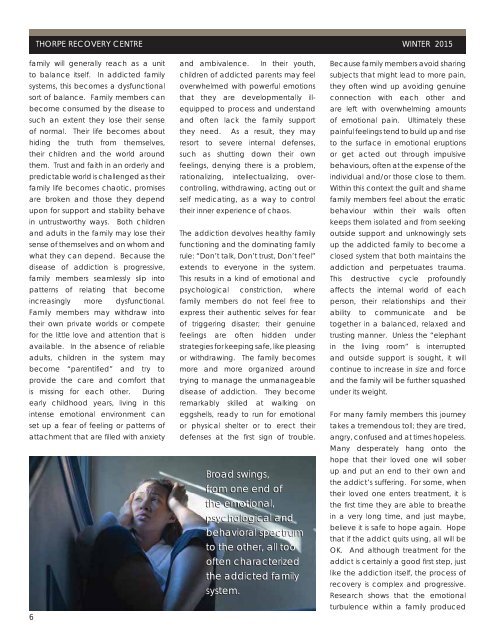Families
Create successful ePaper yourself
Turn your PDF publications into a flip-book with our unique Google optimized e-Paper software.
THORPE RECOVERY CENTRE WINTER 2015<br />
family will generally reach as a unit<br />
to balance itself. In addicted family<br />
systems, this becomes a dysfunctional<br />
sort of balance. Family members can<br />
become consumed by the disease to<br />
such an extent they lose their sense<br />
of normal. Their life becomes about<br />
hiding the truth from themselves,<br />
their children and the world around<br />
them. Trust and faith in an orderly and<br />
predictable world is challenged as their<br />
family life becomes chaotic, promises<br />
are broken and those they depend<br />
upon for support and stability behave<br />
in untrustworthy ways. Both children<br />
and adults in the family may lose their<br />
sense of themselves and on whom and<br />
what they can depend. Because the<br />
disease of addiction is progressive,<br />
family members seamlessly slip into<br />
patterns of relating that become<br />
increasingly more dysfunctional.<br />
Family members may withdraw into<br />
their own private worlds or compete<br />
for the little love and attention that is<br />
available. In the absence of reliable<br />
adults, children in the system may<br />
become “parenti ed” and try to<br />
provide the care and comfort that<br />
is missing for each other. During<br />
early childhood years, living in this<br />
intense emotional environment can<br />
set up a fear of feeling or patterns of<br />
attachment that are lled with anxiety<br />
6<br />
and ambivalence. In their youth,<br />
children of addicted parents may feel<br />
overwhelmed with powerful emotions<br />
that they are developmentally illequipped<br />
to process and understand<br />
and often lack the family support<br />
they need. As a result, they may<br />
resort to severe internal defenses,<br />
such as shutting down their own<br />
feelings, denying there is a problem,<br />
rationalizing, intellectualizing, overcontrolling,<br />
withdrawing, acting out or<br />
self medicating, as a way to control<br />
their inner experience of chaos.<br />
The addiction devolves healthy family<br />
functioning and the dominating family<br />
rule: “Don’t talk, Don’t trust, Don’t feel”<br />
extends to everyone in the system.<br />
This results in a kind of emotional and<br />
psychological constriction, where<br />
family members do not feel free to<br />
express their authentic selves for fear<br />
of triggering disaster; their genuine<br />
feelings are often hidden under<br />
strategies for keeping safe, like pleasing<br />
or withdrawing. The family becomes<br />
more and more organized around<br />
trying to manage the unmanageable<br />
disease of addiction. They become<br />
remarkably skilled at walking on<br />
eggshells, ready to run for emotional<br />
or physical shelter or to erect their<br />
defenses at the rst sign of trouble.<br />
Broad swings,<br />
from one end of<br />
the emotional,<br />
psychological and<br />
behavioral spectrum<br />
to the other, all too<br />
often characterized<br />
the addicted family<br />
system.<br />
Because family members avoid sharing<br />
subjects that might lead to more pain,<br />
they often wind up avoiding genuine<br />
connection with each other and<br />
are left with overwhelming amounts<br />
of emotional pain. Ultimately these<br />
painful feelings tend to build up and rise<br />
to the surface in emotional eruptions<br />
or get acted out through impulsive<br />
behaviours, often at the expense of the<br />
individual and/or those close to them.<br />
Within this context the guilt and shame<br />
family members feel about the erratic<br />
behaviour within their walls often<br />
keeps them isolated and from seeking<br />
outside support and unknowingly sets<br />
up the addicted family to become a<br />
closed system that both maintains the<br />
addiction and perpetuates trauma.<br />
This destructive cycle profoundly<br />
affects the internal world of each<br />
person, their relationships and their<br />
ability to communicate and be<br />
together in a balanced, relaxed and<br />
trusting manner. Unless the “elephant<br />
in the living room” is interrupted<br />
and outside support is sought, it will<br />
continue to increase in size and force<br />
and the family will be further squashed<br />
under its weight.<br />
For many family members this journey<br />
takes a tremendous toll; they are tired,<br />
angry, confused and at times hopeless.<br />
Many desperately hang onto the<br />
hope that their loved one will sober<br />
up and put an end to their own and<br />
the addict’s suffering. For some, when<br />
their loved one enters treatment, it is<br />
the rst time they are able to breathe<br />
in a very long time, and just maybe,<br />
believe it is safe to hope again. Hope<br />
that if the addict quits using, all will be<br />
OK. And although treatment for the<br />
addict is certainly a good rst step, just<br />
like the addiction itself, the process of<br />
recovery is complex and progressive.<br />
Research shows that the emotional<br />
turbulence within a family produced



